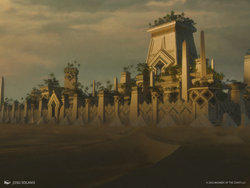Arashin
| Arashin | |
|---|---|
| Information | |
| Plane | Tarkir |
| Colors |
|
| Part of | Shifting Wastes |
| Scryfall Statistics | |
|
16 artworks | |
Arashin (also known as Great Arashin City) is the largest and oldest fortress city of the Abzan clan on the plane of Tarkir. Built on a lush oasis sustained by an underground spring, Arashin is a central stronghold of Abzan society and a symbol of the clan’s enduring commitment to family, fortification, and ancestral tradition.[1]
Description
Arashin stands as the beating heart of Abzan civilization within the Shifting Wastes, a dry and ever-changing region of steppes and deserts. Originally constructed around a giant fortress structure known as the Great Aerie, which once served as Draglonlord Dromoka’s seat of power, Arashin is renowned for its magically fortified walls that can be raised to withstand dragonstorms and other draconic threats. This protective design allows the city to thrive as a secure oasis amidst harsh desert conditions and roaming dragons.[1]
As the clan’s largest settlement, Arashin hosts bustling markets, kin-houses bonded to ancient Kin-Trees, and serves as a hub for traders, artisans, and ancestral rites. Its strategic location and abundant water supply make it a vital refuge for Abzan families and a welcoming haven for travelers and outcasts alike.[1]
History
Arashin’s foundations trace back to the era when Dromoka ruled over the Abzan, outlawing necromancy and destroying Kin-Trees to sever the people’s ties to their ancestors. The Great Aerie, which formed the core of modern Arashin, was Dromoka’s stronghold until the rise of the Abzan rebellion during the New Phyrexian Invasion. After Dromoka’s defeat, the fortress city was reclaimed and transformed into the spiritual and political center of the revived Abzan clan.[1]
Today, Arashin is governed by the Council of Houses, led by Khan Felothar Zanhar. It continues to flourish as the seat of Abzan tradition, where family houses maintain their Kin-Trees, conduct ancestral rites, and uphold the clan’s guiding principle of perennation—preserving the clan for future generations, in life and beyond.[1]
In-game references
- Represented in:
- Associated cards:
- Depicted in:
- Aerie Bowmasters
- Daghatar the Adamant
- Dazzling Ramparts
- Dromoka Monument
- Enduring Scalelord
- Herald of Dromoka
- Mer-Ek Nightblade
- Plains (Khans of Tarkir, #251)
- Plains (Khans of Tarkir, #252)
- Plains (Fate Reforged, #177)
- Plains (Dragons of Tarkir, #250)
- Plains (Dragons of Tarkir, #251)
- Warden of the First Tree
- Quoted or referred to:
References
- ↑ a b c d e Lauren Bond & DK Billins (February 21, 2025). "Planeswalker's Guide to Tarkir: Dragonstorm, Part 1". magicthegathering.com. Wizards of the Coast.
